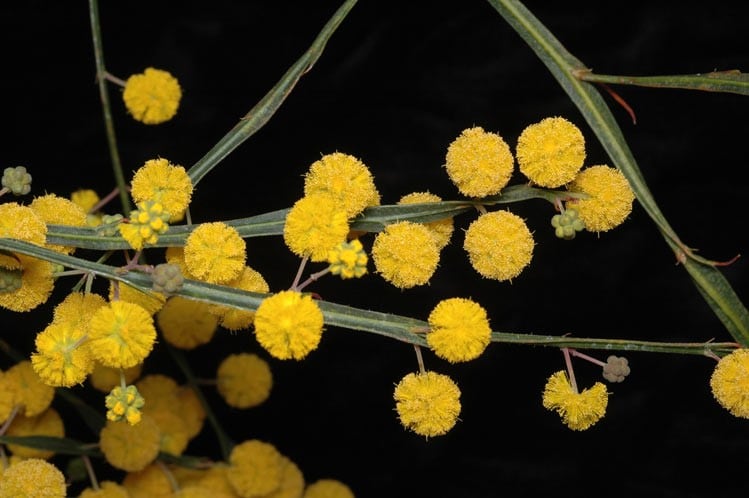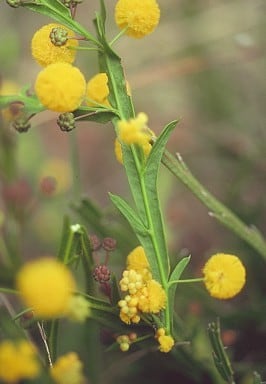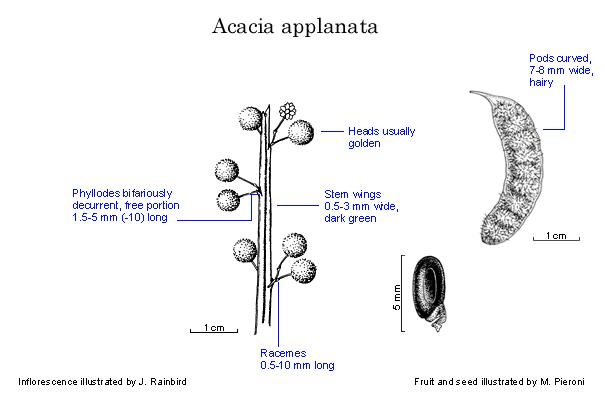Acacia applanata Maslin
WATTLE
Acacias of Australia
Common Name
Grass Wattle
Family
Fabaceae
Distribution
Sporadic from near Jurien (c. 80 km due NW of Lancelin) S to Albany, south-western W.A.
Description
Grass-like subshrub 0.1–0.4 m high, erect or sometimes sprawling with weak, ±prostrate stems, usually single- or few-stemmed from the base, sometimes spreading by subterranean runners. Stipules minute. Phyllodes few, continuous with branchlets, bifariously decurrent and forming opposite wings with each one extending to the next below; wings usually 0.5–3 mm wide, glabrous, pubescent, hirsute or scabridulous and dark green; free portion of phyllodes usually 1.5–5 mm long, commonly spur-like, flat, acute, with nerve close to adaxial margin; gland absent. Inflorescences 1–4-headed racemes; raceme axes 0.5–10 mm long, slender; peduncles 5–12 mm long, slender, glabrous; heads globular,
10–20-flowered, golden; buds obtuse to subacute; bracteoles 0.5 x 0.2–0.4 mm. Flowers 5-merous; sepals united almost to their apices, 1/4–1/3 length of petals; calyx tube 0.8–1.1 mm wide at apex. Pods stipitate, curved, flat, to 3 cm long, 7–10 mm wide, thinly crustaceous, normally densely villous. Seeds transverse, oblong to elliptic, 3.5–4 mm long, brown, arillate.
Habitat
Grows mostly in sand, loam and lateritic soils, often in winter wet depressions, usually in open woodland, woodland and forest, occasionally in shrubland.
Specimens
W.A.: Boonanarring Brook near Gingin, J.J.Alford 161 (PERTH); Albany, 14.5 km along Lower King Rd from Emu Point turn-off, E.M.Bennett 1113 (PERTH); Bayswater, 10 July 1900, A.Morrison (PERTH); 0.6 km W of Bussell Hwy on Ruabon road, between Bunbury and Busselton, B.R.Maslin 2812 (PERTH); 20 km N of Dandaragan on Badgingarra road, B.R.Maslin 6559 (NSW, PERTH).
Notes
Until recently this species was included under A. willdenowiana which is distinguished by its grey-green to glaucous phyllodes, pale yellow to white flower-heads in long racemes which are commonly narrowly winged, and larger pods and seeds; these species are sometimes sympatric or parapatric. Related to A. thieleana and vegetatively resembling A. anomala. Appears to hybridise with A. alata var. alata in a few places in the Darling Ra. near Perth, fide B.R.Maslin, Nuytsia
10: 160 (1995).
Plants at the northern end of the range are more branched at base than plants elsewhere, and their phyllodes may reach 5–7 mm wide with free portions reaching 10 mm long.
FOA Reference
Data derived from Flora of Australia Volumes 11A (2001), 11B (2001) and 12 (1998), products of ABRS, ©Commonwealth of Australia
Author
B.R.Maslin
This identification key and fact sheets are available as a mobile application:
URL: https://apps.lucidcentral.org/wattle/
© Copyright 2018. All rights reserved.














